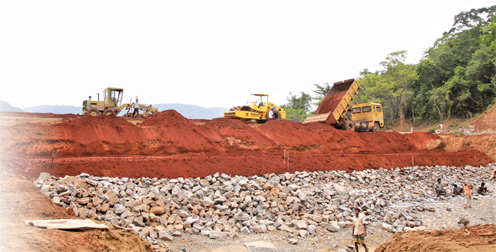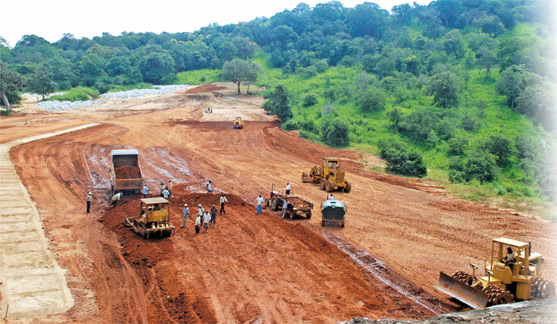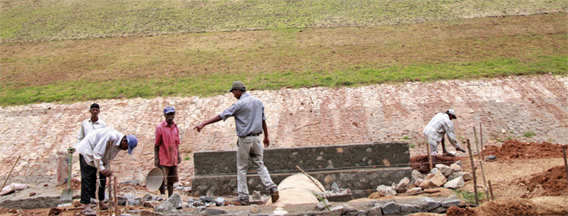|
Final phase of Mahaweli Development Scheme underway:
Drought emphasises need for urgent completion
by Gamini Warushamana
 The final phase of the Mahaweli Development Project (MDP) is now
underway to address water shortages in the Dry Zone up to Northern
province. The prevailing drought has emphasised the need for urgent
completion of the project. The final phase of the Mahaweli Development Project (MDP) is now
underway to address water shortages in the Dry Zone up to Northern
province. The prevailing drought has emphasised the need for urgent
completion of the project.
Additional Secretary, Ministry of Irrigation and Water Resource
Management (MIWRM), Sisira Kumara told Sunday Observer Business that
this project, especially the North Central Province (NCP) canal is the
only way to provide water to remote areas of the NCP and North Province
(NP) and a long-term and sustainable solution for the issue.
Excerpts of the interview.
There is a misconception that the NCP Canal project is only to
provide water to the Iranamadu tank in the North.
Iranamadu tank is the last major reservoir included in the MDP to
provide Mahaweli water under the NCP Canal similar to other major
reservoirs in the NCP which benefited from the diversion of Mahaweli
waters.
In the next 25 years water will become the most important commodity
and sharing this equitably while establishing the water rights of the
farmers who enjoy such rights at present, will be the only way to take
this country to prosperity while improving the living standards of the
poor farming community in the area.
There are three major components of this phase; Moragahakanda and
Kalu Ganga reservoirs and North Central Province (NCP) Canal.
Construction works of the two reservoirs are now under way and are the
last two major reservoirs in the Mahaweli Development Project planned in
1968.
The Moragahakanda reservoir is the most important in the Mahaweli
system to address irrigation water deficit of developed Mahaweli areas
under Polgolla-Amban Ganga complex. The NCP canal will supply water for
irrigation to the areas identified in the Mahaweli master plan, further
North in the Dry Zone.
The capacity of the Moragahakanda reservoir is 570 million cubic
meters (mcm) and the dam is being constructed across Amban Ganga.
The capacity of the Kalu Ganga reservoir is 250 mcm and the dam is
being constructed across the Kalu Ganga.
These two reservoirs will add around 820-mcm additional water
capacity to the existing Mahaweli system enabling added flexibility of
water allocation and will help to reduce the adverse impact of climate
change anticipated in the future.
As per the water balance studies there will be an excess of 100 mcm
of water which could be transferred from Kalu Ganga reservoir to
Moragahakanda to be used in other areas. This excess water in the Kalu
Ganga reservoir will be transferred to Moraghakanda reservoir through a
nine-kilometre long link tunnel.
|

Final phase of Mahaweli Development Scheme underway |
The Mahaweli Authority of Sri Lanka (MASL) has planned to provide
this water to Manankattiya - Mahakandarwa tanks which are in need of
additional water as per the MDP. The total area expected to benefit from
Moraghakanda and Kalu Ganga complex is about 93,122 hectares.
Water rights
There is a misunderstanding among some sectors that once the
Moragahakanda and Kalu Ganga reservoir project are completed, the people
in Polonnaruwa would be deprived of water rights due to the diversion of
the Kaluganga and Ambanganga.
This is not true because water available in the two reservoirs with
the diversion of the Mahaweli river through Polgolla is not sufficient
to provide water beyond Mahakandarawa tank.
In the planning stage of the Kalu Ganga reservoir, the farmers in the
Polonnaruwa area specially the farmers under Parakrama Samudra
irrigation scheme who receive Kalu Ganga water at present through the
Angamedilla diversion scheme protested regarding their water rights.
Accordingly, the Irrigation Department (ID) and Mahaweli Authority of
Sri Lanka (MASL) and GA Polonnaruwa on behalf of the farmers signed a
memorandum of understating that at times of water shortage, priority
will be given to transfer water from either Moragahakanda or Kalu Ganga
reservoirs to Parakrama Samudra and ensure their water rights in the
future.
The NCP canal sub project is vital to address the plight of the
farmers in most remote areas of Kebithigollewa, Horowpothana,
Medawachchiya, Kahatagasdigiliya, Rambewa and Mihintale in the NCP
including Padaviya - Wahalkada and Pavattakulum schemes.
People in Vavuniya and Killinochchi in the Northern Province (NP)
also suffer due to a severe water shortage. Further, an acute kidney
disease is fast spreading in the NCP threatening the lives of the
people.
The provision of safe drinking water has been identified as one of
the measures to combat this disease.
According to areas recognised as Mahaweli areas by the government in
1979 all the people under MDP have an equal right to get their share of
water.
The objectives of MDP are to divert the surplus water of Mahaweli
river basin for irrigation of 365,000 ha to attain self-sufficiency in
food, provision of land and job opportunities to landless people and
hydro-power generation. However, by 2012, 44 years after the launch of
the project, only 150,000 ha or 41 percent of the work has been
completed.
Over time, the government has revised MDP accounting for
socio-economic changes and national development priorities.
The government's present priorities for the irrigation and water
resources sector focus on ensuring availability of water for irrigation
and minimising variations in water availability by implementing
trans-basin diversions to divert water to dry zone areas.
In November 2012 Government approved the Upper Elahera Canal from the
Moragahakanda reservoir to launch the delayed NCP canal project.
NCP Canal area
As originally proposed in the MDP, Moragahakanda and Kalu Ganga are
the main irrigation infrastructure needed for the development of NCP
canal project area.
The Ministry of Irrigation and Water Resource Management (MIWRM)
carried out a comprehensive water balance study and the study considered
present environmental, social and technical constraints.
This study has identified two water sources for optimum use of water
in the Mahaweli river and adjacent river basins.
One is the transfer of water from Randenigala reservoir augmented
with Heen Ganga and Hasalaka reservoirs. The Heen Ganga and Hasalaka are
two major tributaries in the left bank of the Mahaweli river and most of
the water presently flows to the sea through Mahaweli river without
being used.
 Simultaneously it is proposed to divert lower Uma Oya water to
Randenigala through Lower Uma Oya reservoir with the development of
hydro power to compensate power loss due to transfer from Randenigala.
This source will trap the present spillage amounting to about 900 mcm
annually of Mahaweli water from the Minipe anicut located below Mahaweli
major cascade Victoria, Randenigala and Rantambe. Simultaneously it is proposed to divert lower Uma Oya water to
Randenigala through Lower Uma Oya reservoir with the development of
hydro power to compensate power loss due to transfer from Randenigala.
This source will trap the present spillage amounting to about 900 mcm
annually of Mahaweli water from the Minipe anicut located below Mahaweli
major cascade Victoria, Randenigala and Rantambe.
Diversion
The Minipe anicut is the gravity water diversion point to Minipe
scheme (system E) in the Mahaweli left bank and systems C and B under
Maduru Oya reservoir in the Mahaweli right bank.
After allowing for environmental releases and the need of water for
new development projects, it is proposed to divert about 550 mcm
annually from Randenigala using spilling water over Minipe anicut with
another 150 mcm from Heen Ganga and Hasalaka reservoirs to Kalu Ganga
reservoir and will be used to augment the Moragahakanda reservoir.
This route will add additional effective storage (Victoria and
Randenigala) to the Mahaweli system and open another water transfer
route to Moragahakanda reservoir adding flexibility to existing water
transfer systems in the Mahaweli-Amban Ganga complex to mitigate climate
change effects witnessed today and resulting in greater flexibility to
the Mahaweli system.
The second source needs, lifting of water from Mahaweli river at
Kalinganuwara in the Mahaweli river, considered as another ancient water
diversion point combined with Angamedilla in the Amban Ganga. In the
original Mahaweli Master Plan lifting of about 800 mcm of water annually
amounting to about 30% of water requirement of NCP canal development
area is proposed from Angamedilla.
Dry year
Under the proposal, the quantity lift has been reduced to about 300
mcm of water annually to Moragahakanda system.
Even in a very dry year such as 2014 sufficient water is flowing in
the Mahaweli river and part of this water if lifted could be used to
minimise the drought conditions prevailing in the NCP.
This source also will add great flexibility in the operation of the
Mahaweli system facilitating early commencement of cultivation in the
Mahaweli system 'G' area and other existing major irrigation systems and
will pave the way for optimum use of Maha rainfall in the NCP.
Supplementing Moragahakanda from the above two sources it is possible
to provide approximately 1000 mcm from Moragahakanda to NCP Canal area
including 70 mcm is allowed as drinking water. Thus, it should be
clearly understood that full development of NCP canal is possible only
with transfer of water through the above two sources to Moragahakanda
reservoir complex.
Once additional water is transferred then it is possible to extend
the NCP Canal beyond Mahakandarawa tank without affecting the
Polonnaruwa irrigation system. An environment-friendly water diversion
system is proposed from the NCP Canal to feed the minor tank cascade
system.
This comprises about 1,000 tanks situated in the ancient settlement
areas of which major part lies in NCP, north of Anuradhapura and the
balance part in Northern province in an around Vavuniya town, fulfilling
the dream of the farmers in the area.
Neither large-scale system development as done in the past nor new
areas have been proposed for development. The existing forest areas will
be linked to create large forest range areas for co-existence of
wildlife minimising the human-elephant comflict in the area.
Another notable achievement in this project is paving the way for
diversion of the Mahaweli to water scarce Hakwatuna Oya scheme in the
upper Deduru Oya basin and upper Mi Oya irrigation system in the driest
areas of the NWP in the Polpitigama, Galgamuwa and Ehetuwewa and
Yapahuwa Pradeshiya sabah areas fulfilling the dreams of farmers in the
area.
It is estimated that about 130 mcm of water could annually be
transferred to this area through the existing Wemedilla-Dewahuwa water
diversion system while stabilising the systems further.
Climate change
Today, the country is going through one of the severe droughts in
recent times with no rains in some parts of the country for the past
nine months.
The only way to fight future climate change effects, drought and
floods in the NCP is to add storage capacity to the Mahaweli system. The
proposed supplementary water diversions linking the existing and
proposed irrigation infrastructure will minimise these effects in the
future. |

